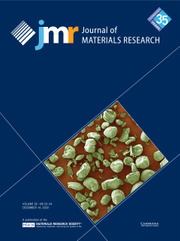Crossref Citations
This article has been cited by the following publications. This list is generated based on data provided by
Crossref.
Pishtshev, A.
Karazhanov, S. Zh
and
Klopov, M.
2014.
Materials properties of magnesium and calcium hydroxides from first-principles calculations.
Computational Materials Science,
Vol. 95,
Issue. ,
p.
693.
Rashid, Muhammad
Hussain, Fayyaz
Imran, Muhammad
Abo, Gavin S.
Ahmad, S.A.
and
Ping Feng, Yuan
2014.
First-principles study of structural, electronic and optical properties of Zn1−xMgxO ternary alloys using modified Becke–Johnson potential.
Materials Science in Semiconductor Processing,
Vol. 18,
Issue. ,
p.
114.
Wang, Yaqin
Tang, Wu
Zhu, Junhao
and
Liu, Jie
2015.
Strain induced change of band structure and electron effective mass in wurtzite ZnO: A first-principles study.
Computational Materials Science,
Vol. 99,
Issue. ,
p.
145.
Bechstedt, Friedhelm
2015.
Many-Body Approach to Electronic Excitations.
Vol. 181,
Issue. ,
p.
539.
Rondinelli, James M.
and
Kioupakis, Emmanouil
2015.
Predicting and Designing Optical Properties of Inorganic Materials.
Annual Review of Materials Research,
Vol. 45,
Issue. 1,
p.
491.
Varley, Joel B
and
Schleife, André
2015.
Bethe–Salpeter calculation of optical-absorption spectra of In2O3and Ga2O3.
Semiconductor Science and Technology,
Vol. 30,
Issue. 2,
p.
024010.
Riefer, A
Weber, N
Mund, J
Yakovlev, D R
Bayer, M
Schindlmayr, Arno
Meier, C
and
Schmidt, W G
2017.
Zn–VI quasiparticle gaps and optical spectra from many-body calculations.
Journal of Physics: Condensed Matter,
Vol. 29,
Issue. 21,
p.
215702.
Pishtshev, A.
and
Karazhanov, S. Zh.
2017.
Structure-property relationships in cubic cuprous iodide: A novel view on stability, chemical bonding, and electronic properties.
The Journal of Chemical Physics,
Vol. 146,
Issue. 6,
Schleife, André
Zhang, Xiao
Li, Qi
Erhart, Paul
and
Åberg, Daniel
2017.
Excitons in scintillator materials: Optical properties and electron-energy loss spectra of NaI, LaBr3, BaI2, and SrI2.
Journal of Materials Research,
Vol. 32,
Issue. 1,
p.
56.
Krasil'nikov, V.N.
Baklanova, I.V.
Zhukov, V.P.
Medvedeva, N.I.
Tyutyunnik, A.P.
Samigullina, R.F.
Gyrdasova, O.I.
and
Melkozerova, M.A.
2017.
The luminescence properties of γ-Al 2 O 3 :C produced by precursor method.
Journal of Alloys and Compounds,
Vol. 698,
Issue. ,
p.
1102.
Ekuma, C. E.
2018.
Two-particle excitations under coexisting electron interaction and disorder.
Physical Review B,
Vol. 98,
Issue. 8,
Schleife, André
Neumann, Maciej D
Esser, Norbert
Galazka, Zbigniew
Gottwald, Alexander
Nixdorf, Jakob
Goldhahn, Rüdiger
and
Feneberg, Martin
2018.
Optical properties of In2O3 from experiment and first-principles theory: influence of lattice screening.
New Journal of Physics,
Vol. 20,
Issue. 5,
p.
053016.
Nabok, Dmitrii
Höffling, Benjamin
and
Draxl, Claudia
2019.
Energy-Level Alignment at Organic/Inorganic Interfaces from First Principles: Example of Poly(para-phenylene)/Rock-Salt ZnO(100).
Chemistry of Materials,
Vol. 31,
Issue. 18,
p.
7143.
Kang, Kisung
Kononov, Alina
Lee, Cheng-Wei
Leveillee, Joshua A.
Shapera, Ethan P.
Zhang, Xiao
and
Schleife, André
2019.
Pushing the frontiers of modeling excited electronic states and dynamics to accelerate materials engineering and design.
Computational Materials Science,
Vol. 160,
Issue. ,
p.
207.
Niedermaier, Matthias
Schwab, Thomas
Dolcet, Paolo
Bernardi, Johannes
Gross, Silvia
Bockstedte, Michel
and
Diwald, Oliver
2019.
Cobalt and Iron Ions in MgO Nanocrystals: Should They Stay or Should They Go.
The Journal of Physical Chemistry C,
Vol. 123,
Issue. 42,
p.
25991.
Begum, Vijaya
Gruner, Markus E.
Vorwerk, Christian
Draxl, Claudia
and
Pentcheva, Rossitza
2021.
Theoretical description of optical and x-ray absorption spectra of MgO including many-body effects.
Physical Review B,
Vol. 103,
Issue. 19,
Onuma, Takeyoshi
Kosaka, Wataru
Kudo, Kanta
Ota, Yuichi
Yamaguchi, Tomohiro
Kaneko, Kentaro
Fujita, Shizuo
and
Honda, Tohru
2021.
Identification of free and bound exciton emission of MgO single crystal in vacuum ultraviolet spectral range.
Applied Physics Letters,
Vol. 119,
Issue. 13,
Aggoune, Wahib
Irmscher, Klaus
Nabok, Dmitrii
Vona, Cecilia
Bin Anooz, Saud
Galazka, Zbigniew
Albrecht, Martin
and
Draxl, Claudia
2021.
Fingerprints of optical absorption in the perovskite
LaInO3
: Insight from many-body theory and experiment.
Physical Review B,
Vol. 103,
Issue. 11,
Zhang, Xiao
Achilles, Sebastian
Winkelmann, Jan
Haas, Roland
Schleife, André
and
Di Napoli, Edoardo
2021.
Solving the Bethe-Salpeter equation on massively parallel architectures.
Computer Physics Communications,
Vol. 267,
Issue. ,
p.
108081.
Li, Rukang K.
2021.
Excitonic Nature of the Band‐Edge Absorptions in Borate Nonlinear Optical Materials.
Advanced Photonics Research,
Vol. 2,
Issue. 7,


